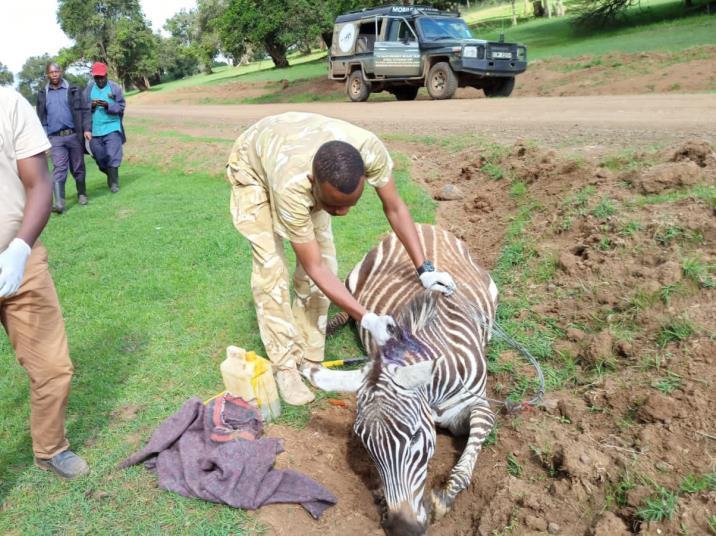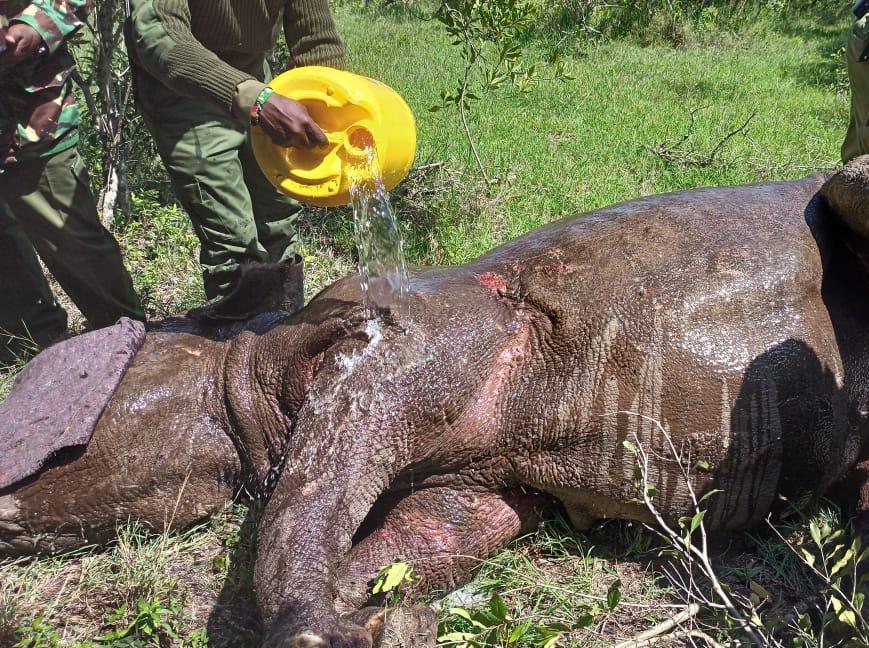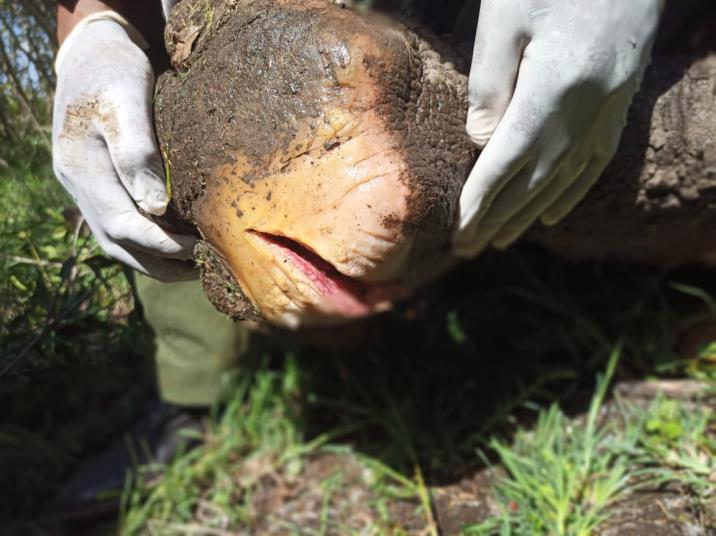SWT/KWS MT. KENYA MOBILE VETERINARY UNIT

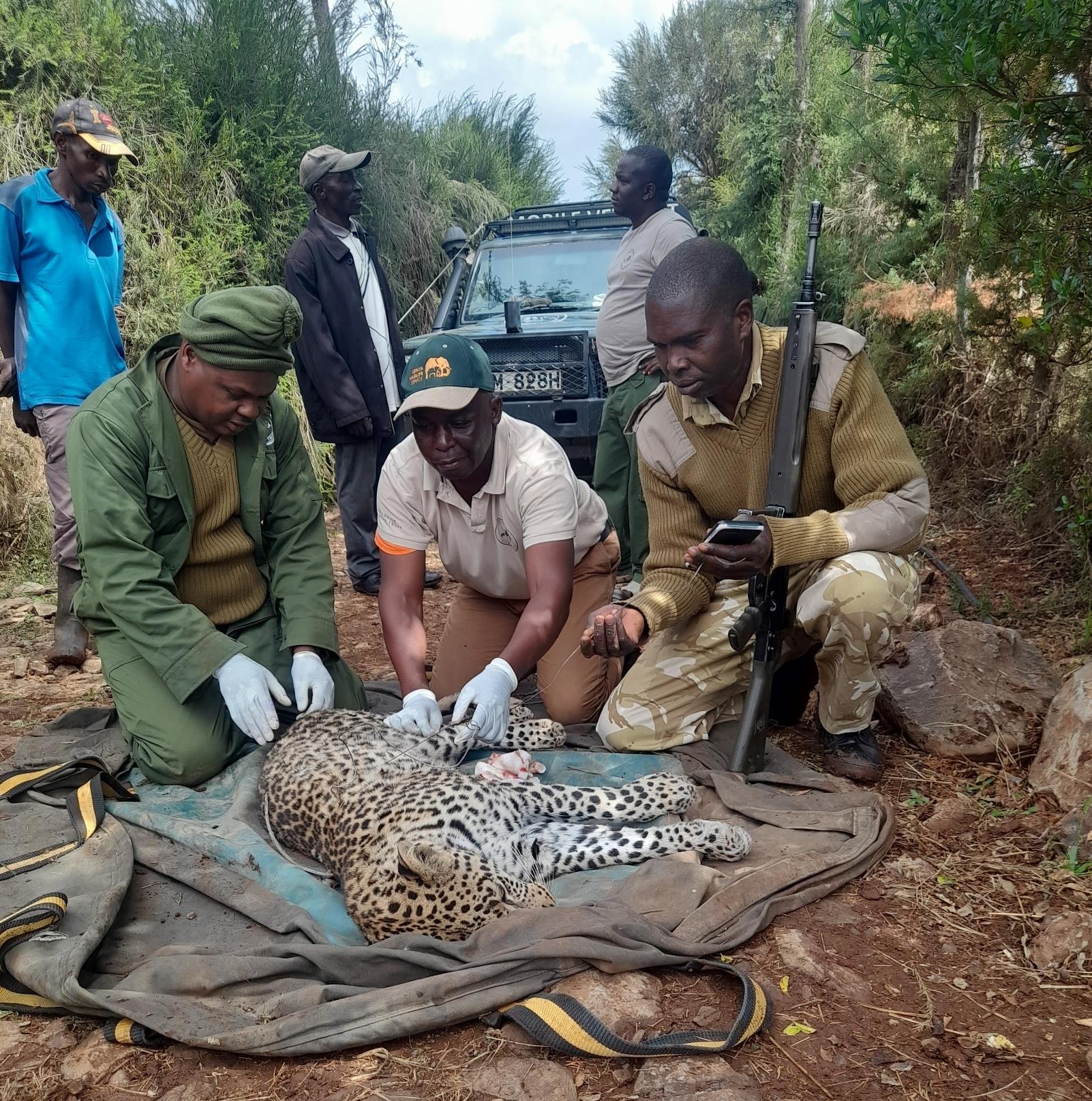
DECEMBER 2022

Introduction
8 Cases in December
December Report by Dr. Dominic Mijele
1 Rhino Case
1 Elephant Case
In December 2022, the Mt. Kenya Mobile Veterinary Unit attended to all reported wildlife emergencies in the Laikipia ecosystem and the Mt. Kenya region. The Unit attended to 6 cases in total. These included 3 mountain bongo cases (Heri, Gift and Tikki), 1 leopard case, 1 eland case, 1 zebra case, 1 elephant case and 1 black rhino case.
One of the highlights in December was the rescue of a male leopard caught in a snare within community farms in Timau. Luckily, the snare around the neck had only caused minor abrasion wounds, the leopard was successfully treated and later relocated to Loisaba Conservancy. The Unit also attended to an elephant cow in Loisaba Conservancy that was bleeding from the shoulder after being shot with an arrow. The elephant was successfully treated and given a good prognosis for full recovery.
Acknowledgement
We greatly appreciate the Sheldrick Wildlife Trust (SWT) for its continued support which has enabled the Mt Kenya Veterinary Unit to respond promptly to wildlife emergencies and offer lifesaving treatment
Case Details



Bongo

Natural Causes
Heri, an adult female mountain bongo, was reported to be limping
Immobilisation, examination and treatment
Mt. Kenya Wildlife Conservancy
Heri was approached on foot and darted on the right rump with 5 mgs Etorphine and 40 mgs Azaperone. She went down on left lateral recumbency 5 minutes post-darting, then she shifted to sternal recumbency. She was physically restrained, and Oxygen supplementation administered to enhance respiration Heri was in good body condition, she had overgrown hooves and a broken left front hoof. 4,000 mgs Phenylbutazone and 3,000 mgs Amoxicillin were administered then the broken hoof was debrided with Hydrogen peroxide, flushed with Iodine and sprayed with Oxytetracycline. The overgrown hooves were also trimmed Anaesthesia was reversed thereafter with 100 mgs Naltrexone administered via the jugular vein. She rose 2 minutes post-reversal.
Prognosis
Heri has a good prognosis
Bongo
Natural Causes
Mt. Kenya Wildlife Conservancy
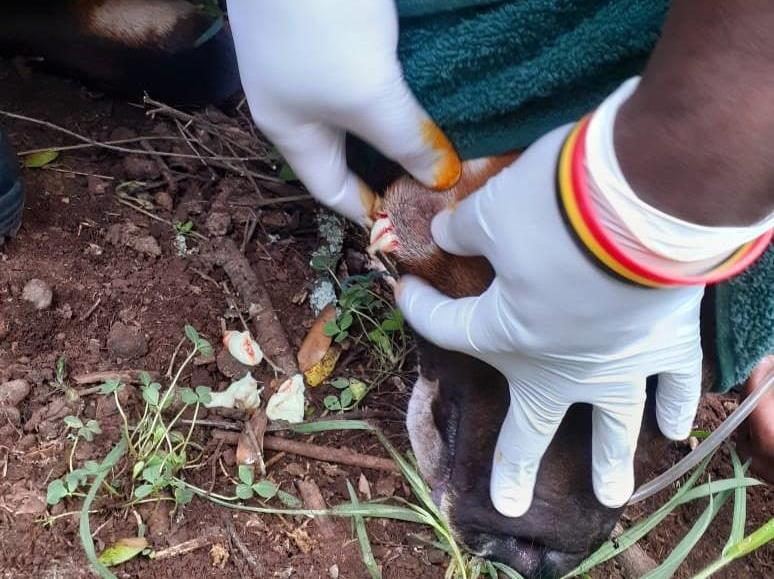
Gift, a sub-adult female mountain bongo, was reported to have an abscess on the right jaw.
Immobilisation, examination and treatment
Gift was darted on the right rump with 2 mgs Etorphine and 20 mgs Azaperone When the drug took effect after 5 minutes, she went down on left lateral recumbency then she shifted to sternal recumbency. She was then physically restrained thereafter, and Oxygen supplementation administered. Gift was observed to be in good body condition; however, she had an abscess on the right jaw. 20 mgs Dexamethasone, 10 mls Catasol, and 1,500 mgs Amoxicillin were administered intramuscularly while 50 mgs Ivermectin was injected subcutaneously. The abscess was lanced, and the pus it contained was drained. The pocket was then debrided with Hydrogen peroxide and flushed with Iodine before anaesthesia was reversed with 50 mgs Naltrexone administered via the jugular vein. Gift rose 2 minutes post-reversal.
Prognosis
Gift had a good prognosis.
Bongo
Natural Causes
Mt. Kenya Wildlife Conservancy
Tikki, an adult male mountain bongo, received follow up treatment for injuries sustained during a fight



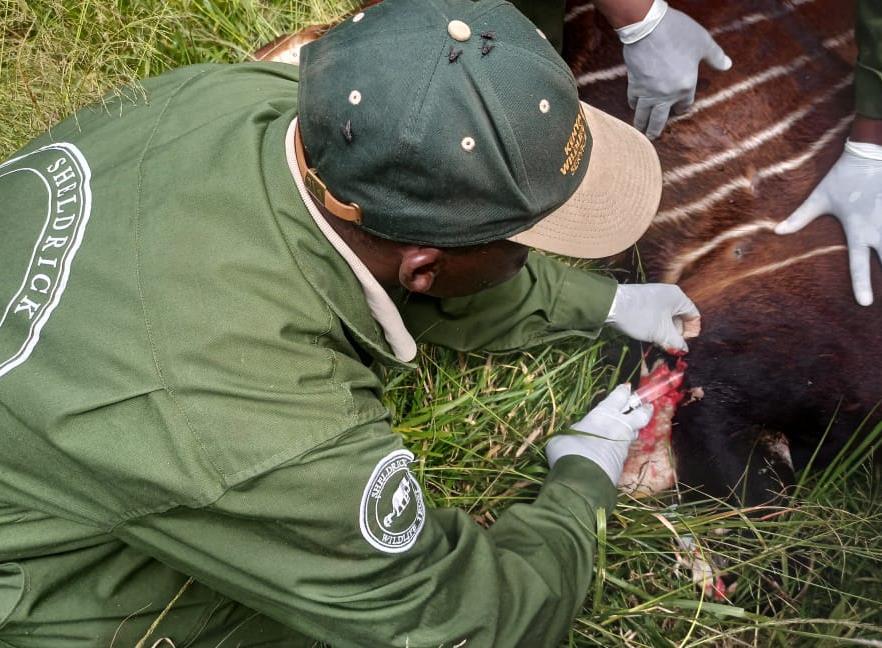
Immobilisation, examination and treatment
Tikki was approached on foot and darted on the right rump muscles with 5 mgs Etorphine and 50 mgs Azaperone. The drug took effect 5 minutes post darting. He was physically restrained while in sternal recumbency and given Oxygen to enhance respiration. The open deep wound at the base of the neck had developed granulation tissue and it was closing which is a good sign of healing. There was development of subcutaneous emphysema on the shoulder region, triceps muscles, and right front limb muscles. This had also extended to the hind limbs. 9,000 mgs Amoxicillin and 20 mls Catosal were administered intramuscularly, green clay paste was also injected subcutaneously into the emphysematous sites. Anaesthesia was reversed thereafter with 100 mgs Naltrexone administered via the jugular vein. He rose 2 minutes later.
Prognosis
Tikki has a good prognosis for full recovery
Leopard Snared Timau Area
An adult male leopard was caught in a snare within the community farms in Timau. The leopard was rescued from the snare and later relocated to Loisaba Conservancy.


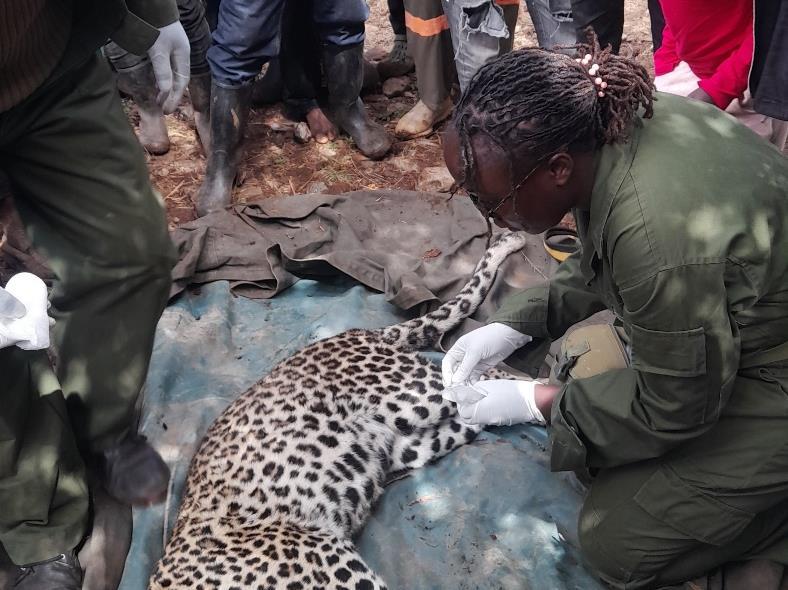
Immobilisation, examination and treatment
The leopard was approached on foot and darted on the right rump with 160 mgs Ketamine (100 mgs/ml) and 1.6 mgs Medetomidine (1mg/ml). The animal was in good body condition, it had a snare around the neck that had caused a minor abrasion. The snare was removed then the wound was flushed with Iodine and sprayed with Oxytetracycline. Blood samples were collected from the femoral vein for EDTA/whole blood and serum analysis. Tissue samples were also collected and preserved in ethanol for further analysis. Anaesthesia was reversed an hour post-darting with 10 mgs Atipamazole and 6.5 mgs Yohimbine administered intramuscularly. The leopard rose 5 minutes later.
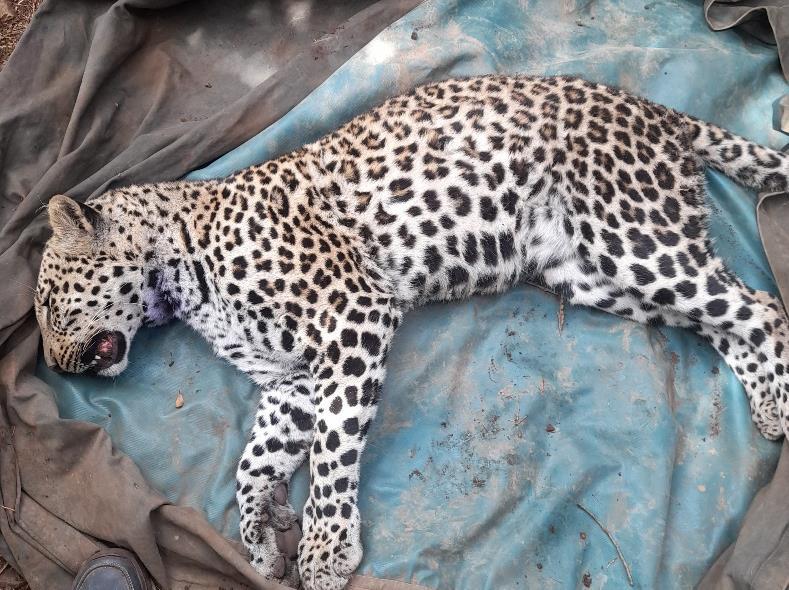
Relocation and prognosis
The leopard has a good prognosis, and it was later relocated to Loisaba Conservancy.
Eland Snared Aberdares Country Club



Aberdares Country Club staff reported an adult male eland with a snare around the left front limb.
Immobilisation, examination and treatment
The eland was approached by vehicle and darted on the right shoulder with 12 mgs Etorphine and 50 mgs Azaperone. The drugs took effect 7 minutes post-darting with the animal going down on sternal recumbency. The eland was in good body condition, but it had a snare around the left front leg that had inflicted a deep wound. 3,000mgs Amoxicillin was administered intramuscularly then the wound was flushed with Iodine and sprayed with Oxytetracycline after the snare was removed. Anaesthesia was then reversed with 100 mgs Naltrexone administered via the jugular vein; the animal rose 2 minutes post-reversal

Prognosis
The eland has a good prognosis.






